Visible to Intel only — GUID: GUID-28FCB365-D95F-45FC-AD9C-6094120C49E4
Visible to Intel only — GUID: GUID-28FCB365-D95F-45FC-AD9C-6094120C49E4
Flow Graph Basics: Reservation
oneAPI Threading Building Blocks (oneTBB) flow graph join_node has four possible policies: queueing, reserving, key_matching and tag_matching. join_nodes need messages at every input before they can create an output message. The reserving join_node does not have internal buffering, and it does not pull messages from its inputs until it has a message at each input. To create an output message it temporarily reserves a message at each input port, and only if all input ports succeed reserving messages will an output message be created. If any input port fails to reserve a message, no message will be pulled by the join_node.
To support the reserving join_node some nodes support reservation of their outputs. The way reservation works is:
When a node connected to a reserving join_node in push state tries to push a message, the join_node always rejects the push and the edge connecting the nodes is switched to pull mode.
The reserving input port calls try_reserve on each edge in pull state. This may fail; if so, the reserving input port switches that edge to push state, and tries to reserve the next node connected by an edge in pull state. While the input port’s predecessor is in reserved state, no other node can retrieve the reserved value.
If each input port successfully reserves an edge in pull state, the reserving join_node will create a message using the reserved messages and try to push the resulting message to any nodes connected to it.
If the message is successfully pushed to a successor, the predecessors that were reserved are signaled that the messages were used (by calling try_consume().) Those messages will be discarded by the predecessor nodes, because they have been successfully pushed.
If the message was not successfully pushed to any successor, the predecessors that were reserved are signaled that the messages were not used (by calling try_release().) At this point, the messages may be pushed to or pulled by other nodes.
Because the reserving join_node will only attempt to push when each input port has at least one edge in a pull state, and will only attempt to create and push a message if all input ports succeed reserving messages, at least one of the predecessors to each of the reserving join_node input ports must be reservable.
The following example demonstrates a reserving join_node’s behavior. buffer_nodes buffer their output, so they accept a switch of their output edge from push to pull mode. broadcast_nodes do not buffer messages and do not support try_get() or try_reserve().
void run_example2() { // example for Flow_Graph_Reservation.xml
graph g;
broadcast_node<int> bn(g);
buffer_node<int> buf1(g);
buffer_node<int> buf2(g);
typedef join_node<tuple<int,int> reserving> join_type;
join_type jn(g);
buffer_node<join_type::output_type> buf_out(g);
join_type::output_type tuple_out;
int icnt;
// join_node predecessors are both reservable buffer_nodes
make_edge(buf1,input_port<0>jn));
make_edge(bn,input_port<0>jn)); // attach a broadcast_node
make_edge(buf2,input_port<1>jn));
make_edge(jn, buf_out);
bn.try_put(2);
buf1.try_put(3);
buf2.try_put(4);
buf2.try_put(7);
g.wait_for_all();
while (buf_out.try_get(tuple_out)) {
printf("join_node output == (%d,%d)\n",get<0>tuple_out), get<1>tuple_out) );
}
if(buf1.try_get(icnt)) printf("buf1 had %d\n", icnt);
else printf("buf1 was empty\n");
if(buf2.try_get(icnt)) printf("buf2 had %d\n", icnt);
else printf("buf2 was empty\n");
}
In the example above, port 0 of the reserving join_nodejn has two predecessors: a buffer_nodebuf1 and a broadcast_nodebn. Port 1 of the join_node has one predecessor, buffer_nodebuf2.
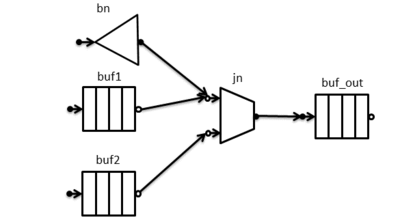
We will discuss one possible execution sequence (the scheduling of tasks may differ slightly, but the end result will be the same.)
bn.try_put(2);
bn attempts to forward 2 to jn. jn does not accept the value and the arc from bn to jn reverses. Because neither bn nor jn buffer messages, the message is dropped. Because not all the inputs to jn have available predecessors, jn does nothing further.

buf1.try_put(3);
buf1 attempts to forward 3 to jn. jn does not accept the value and the arc from buf1 to jn reverses. Because not all the inputs to jn have available predecessors, jn does nothing further.
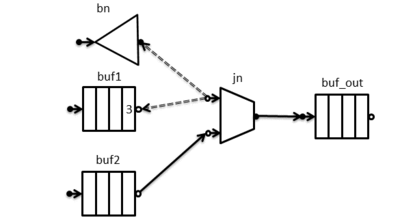
buf2.try_put(4);
buf2 attempts to forward 4 to jn. jn does not accept the value and the arc from buf2 to jn reverses. Now both inputs of jn have predecessors, a task to build and forward a message from jn will be spawned. We assume that task is not yet executing.
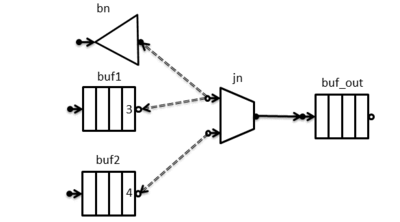
buf2.try_put(7);
buf2 has no successor (because the arc to jn is reversed,) so it stores the value 7.
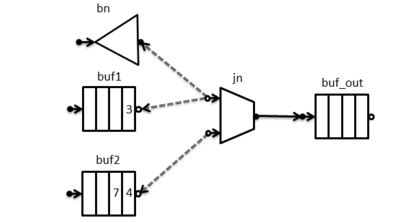
Now the task spawned to run jn runs.
jn tries to reserve bn, which fails. The arc to bn switches back to the forward direction.
jn tries to reserve buf1, which succeeds (reserved nodes are colored grey.) jn receives the value 3 from buf1, but it remains in buf1 (in case the attempt to forward a message from jn fails.)
jn tries to reserve buf2, which succeeds. jn receives the value 4 from buf2, but it remains in buf2.
jn constructs the output message tuple<3,4>.
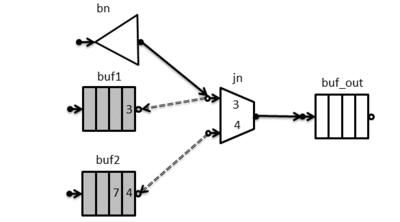
Now jn pushes its message to buf_out, which accepts it. Because the push succeeded, jn signals buf1 and buf2 that the reserved values were used, and the buffers discard those values. Now jn attempts to reserve again.
No attempt to pull from bn is made, because the edge from bn to jn is in push state.
jn tries to reserve buf1, which fails. The arc to buf1 switches back to the forward direction.
jn does not try any further actions.
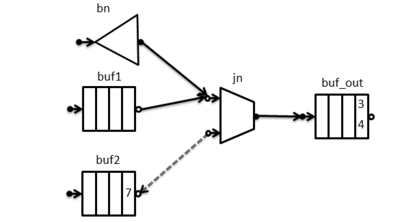
No further activity occurs in the graph, and the wait_for_all() will complete. The output of this code is
join_node output == (3,4) buf1 was empty buf2 had 7